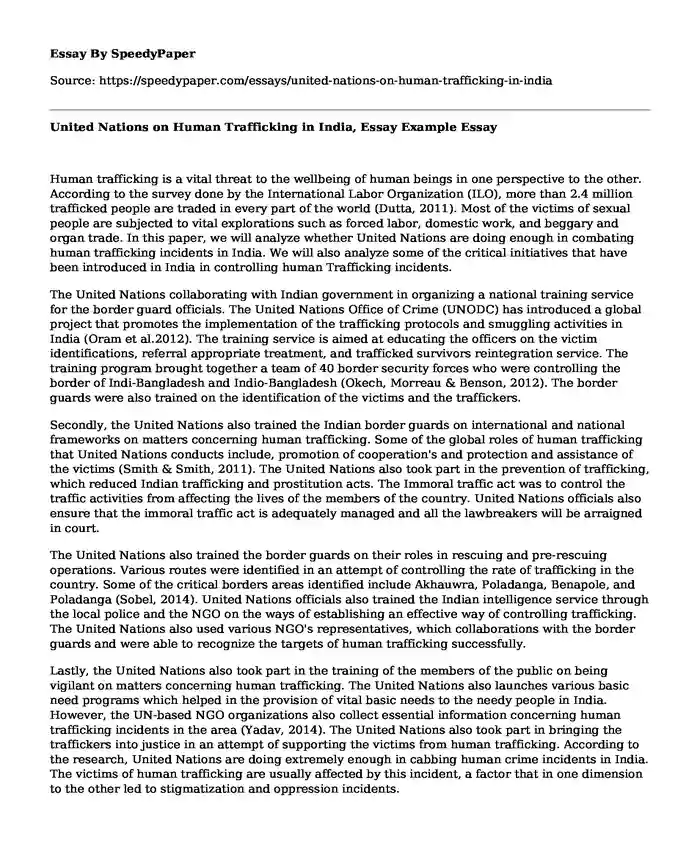
| Type of paper: | Essay |
| Categories: | Human rights Human trafficking |
| Pages: | 3 |
| Wordcount: | 760 words |
Human trafficking is a vital threat to the wellbeing of human beings in one perspective to the other. According to the survey done by the International Labor Organization (ILO), more than 2.4 million trafficked people are traded in every part of the world (Dutta, 2011). Most of the victims of sexual people are subjected to vital explorations such as forced labor, domestic work, and beggary and organ trade. In this paper, we will analyze whether United Nations are doing enough in combating human trafficking incidents in India. We will also analyze some of the critical initiatives that have been introduced in India in controlling human Trafficking incidents.
The United Nations collaborating with Indian government in organizing a national training service for the border guard officials. The United Nations Office of Crime (UNODC) has introduced a global project that promotes the implementation of the trafficking protocols and smuggling activities in India (Oram et al.2012). The training service is aimed at educating the officers on the victim identifications, referral appropriate treatment, and trafficked survivors reintegration service. The training program brought together a team of 40 border security forces who were controlling the border of Indi-Bangladesh and Indio-Bangladesh (Okech, Morreau & Benson, 2012). The border guards were also trained on the identification of the victims and the traffickers.
Secondly, the United Nations also trained the Indian border guards on international and national frameworks on matters concerning human trafficking. Some of the global roles of human trafficking that United Nations conducts include, promotion of cooperation's and protection and assistance of the victims (Smith & Smith, 2011). The United Nations also took part in the prevention of trafficking, which reduced Indian trafficking and prostitution acts. The Immoral traffic act was to control the traffic activities from affecting the lives of the members of the country. United Nations officials also ensure that the immoral traffic act is adequately managed and all the lawbreakers will be arraigned in court.
The United Nations also trained the border guards on their roles in rescuing and pre-rescuing operations. Various routes were identified in an attempt of controlling the rate of trafficking in the country. Some of the critical borders areas identified include Akhauwra, Poladanga, Benapole, and Poladanga (Sobel, 2014). United Nations officials also trained the Indian intelligence service through the local police and the NGO on the ways of establishing an effective way of controlling trafficking. The United Nations also used various NGO's representatives, which collaborations with the border guards and were able to recognize the targets of human trafficking successfully.
Lastly, the United Nations also took part in the training of the members of the public on being vigilant on matters concerning human trafficking. The United Nations also launches various basic need programs which helped in the provision of vital basic needs to the needy people in India. However, the UN-based NGO organizations also collect essential information concerning human trafficking incidents in the area (Yadav, 2014). The United Nations also took part in bringing the traffickers into justice in an attempt of supporting the victims from human trafficking. According to the research, United Nations are doing extremely enough in cabbing human crime incidents in India. The victims of human trafficking are usually affected by this incident, a factor that in one dimension to the other led to stigmatization and oppression incidents.
References
Dutta, M. (2011). Cultural dimensions of human trafficking in India. International Journal of Arts & Sciences, 4(13), 93.Retrived from http://search.proquest.com/openview/220ed8168bca3e01ee8812e5a678685a/1?pq-origsite=gscholar&cbl=626342
Okech, D., Morreau, W., & Benson, K. (2012). Human trafficking: Improving victim identification and service provision. International Social Work, 55(4), 488-503.Retrived from https://journals.sagepub.com/doi/abs/10.1177/0020872811425805
Oram, S., Stockl, H., Busza, J., Howard, L. M., & Zimmerman, C. (2012). Prevalence and risk of violence and the physical, mental, and sexual health problems associated with human trafficking: systematic review. PLoS medicine, 9(5), e1001224.Retrived from https://journals.plos.org/plosmedicine/article?id=10.1371/journal.pmed.1001224
Smith, C. A., & Smith, H. M. (2011). Human trafficking: The unintended effects of United Nations intervention. International Political Science Review, 32(2), 125-145.Retrived from https://journals.sagepub.com/doi/abs/10.1177/0192512110371240
Sobel, M. R. (2014). Chronicling a crisis: Media framing of human trafficking in India, Thailand, and the USA. Asian Journal of Communication, 24(4), 315-332.Retrived from https://www.tandfonline.com/doi/abs/10.1080/01292986.2014.903425
Yadav, M. (2014). India's Human Rights Credentials and Role in United Nations and its Quest to Get United Nations Security Council Permanent Seat with or Without Veto Power. IOSR Journal Of Humanities And Social Science (IOSR-JHSS) Volume, 19, 04-13.Retrived from https://papers.ssrn.com/sol3/papers.cfm?abstract_id=2833132
Cite this page
United Nations on Human Trafficking in India, Essay Example. (2022, Feb 16). Retrieved from https://speedypaper.net/essays/united-nations-on-human-trafficking-in-india
Request Removal
If you are the original author of this essay and no longer wish to have it published on the SpeedyPaper website, please click below to request its removal:
- Free Essay: How Corporate Governance Is Implemented in the UK
- Free Essay on Charles Dickens' Great Expectations
- Law Essay Sample: Coles and Woolworth's Breached Shopper-Docket Undertakings
- Free Essay with Financial Statement Analysis
- Position Paper Sample on Visual Literacy
- Literary Essay Sample: Themes in The Story of an Hour by Kate Chopin
- Paper Example. Consumer Portrait
Popular categories




